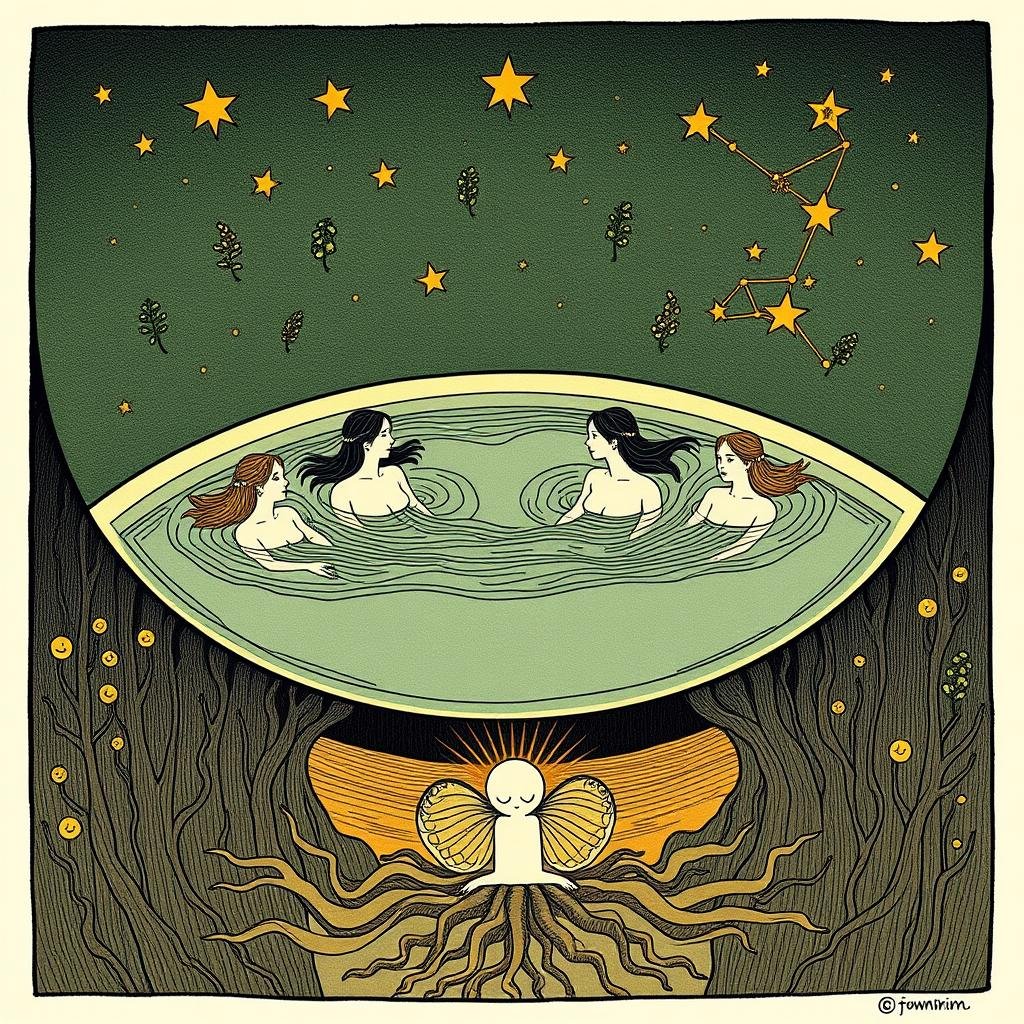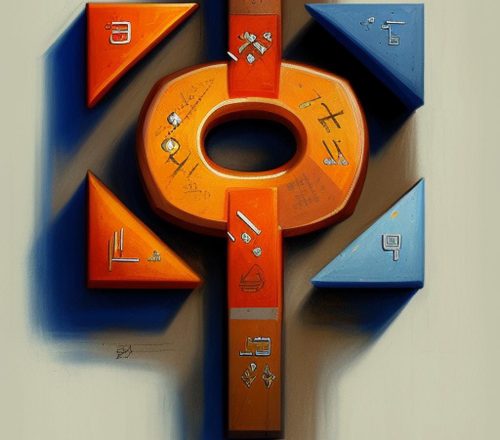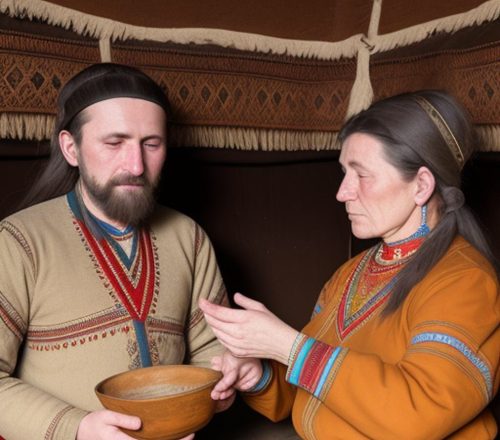
Table of Contents
Strange Bathing Folios of the Voynich Manuscript
Strange? Yes… that insight is very sharp… and very telling.
The bathing folios of the Voynich Manuscript are strange, even sophisticated:
- Women immersed in vats, channels, tubs, pools
- Flowing pipes and streams, sometimes branching like lymph or irrigation systems
- Often naked, calmly interacting, sometimes with what seem like stars, herbs, or celestial markers
It doesn’t feel like medieval fantasy. It feels systematic. Deliberate.
A ritual hydrotherapy… more intuitive than scientific, but possibly more wise than either.
🛁 A Few Directions the Baths May Whisper
1. Lunar / Womb Tending
- Women soaking according to moon phase, bleeding cycle, or grief process
- Baths as ritual renewal: rebirthing chambers, moon-sync tools
2. Sensory Healing (for the “mad” or “sensitive”)
- The “mad” is poignant… yes:
In many eras, baths were used to soothe agitation, cool fevers, or contain emotional overwhelm - These women may have been priestesses, seers, or simply “too sensitive” for the harsh world. A manuscript of gentle care for the overstimulated
3. Elemental Tuning
- Water as the medium for herbs, sound, star-aligned rituals
- The vats may be energetic filters, where the body is “retuned” to rhythm… like cleansing instruments
✨ What Makes It Feel So Advanced?
- Non-moralizing nudity: bodies shown with care, not shame
- Plumbing-like diagrams: possible knowledge of circulatory or energetic mapping
- Group settings: not solitary madness, but shared healing
- Suggests not “bathing for filth” but bathing for realignment
So yes… it feels like the opposite of confinement.
Not a place for fools.
A place for those who needed stillness.
A temple of returning.
🔍 Contemporary and Historical Parallels
Medieval texts on bathing and herb use (especially those practiced by women),do exist, though most come without the whisper of ritual incantation found in the Voynich. Instead, they offer structural context for how baths functioned as both healing and ceremonial tools.
1. De Balneis / Medieval Spa Poems
Inspired by Roman thermal heritage, De Balneis Puteolanis (circa 13th century) describes a variety of baths around Naples(indoor pools, steam caves, thermal plunge pools) often richly illustrated and used for healing and leisure. It shows the presence of medicinal bathing traditions among elites.wyldstudio.com+3wortsandcunning.com+3Academia+3JSTOR Daily
2. Therapeutic Baths in Medieval English Medicine
From early Anglo‑Saxon remedies to later manuscripts like the Lacnunga or Bald’s Leechbook, medieval English medicine included baths as part of treatment protocols. Women especially were given hot herb baths with rainwater to induce sweat, ease womb ailments, or promote conception. Wikipedia+3Academia+3Queen’s University Belfast+3
3. The Salernitan Tradition
At the famed Schola Medica Salernitana in 11th–13th centuries, practitioners like Trotula of Salerno championed women’s medicine, including hygiene, bathing and herbal remedies. The Trotula texts (and Practica secundum Trotam) were widely circulated in Latin and vernacular forms. They stress hygiene, hot baths, topical salves, and herbs for reproductive health. Queen’s University Belfast+3Wikipedia+3Wikipedia+3
4. The Tacuinum Sanitatis
A richly illustrated Latin/Arabic herbal handbook from the 14th–15th centuries, it includes advice on food, bodily humor, and occasional references to herbal baths (e.g. hot water with thyme for warmth and well-being). While not full ritual bath guides, the visual and textual mix resembles the Voynich’s herbal diagrams. Wikipediarosaliegilbert.com
🌐 What Makes the Voynich Unique?
| Traditional Texts | Voynich Manuscript |
| Prescriptive prose: “boil root, drink tea” | Mnemonic chant-stanzas: qokedy / shedy / raas |
| Baths described in Latin or vernacular | Bath diagrams with star and herb alignment; women in tubs |
| Female hygiene and midwifery normalized | Bathing scenes exclusively featuring women, unashamed and central |
| Emphasis on medicine and humor balance | Emphasis on breath, rhythm, timing—not just recipe mechanics |
🛁 Medieval Baths as Ritual, Healing, Identity
Voynich’s bathing scenes are far from mundane. They evoke not only Roman luxury but also lost threads of women’s ritual and therapeutic tradition. These scenes feel subtly sophisticated, more temple than tub.
🌍 Public & Domestic Baths. A Common Past
- Medieval Europe, contrary to myth, was very familiar with bathing. By the 13th century, cities like Paris and London had dozens of public bathhouses, often connected to bakeries for heating purposes mikkelaaland.com+2Medievalists.net+2Nicholas C. Rossis+2.
- Bathing was not only hygiene. It was social ceremony, accompanied by sensory experience: herbs, flowers, wine, and music in some cases rosaliegilbert.comrosaliegilbert.com.
💆 Therapeutic Practice in the Bathhouse
- Bathhouses often served as early clinics, run by baders (bath-keepers) who performed basic medical care: steam therapy, herbal concoctions, cupping, sometimes even minor surgery Facebook+2The Scientist+2YouTube+2.
- In medical texts like the Salernitan Regimen Sanitatis, bathing is featured as central to seasonal well‑being and physical treatise JSTOR Daily.
🪴 Ritual & Medical Baths for Women
- Women in medieval medicine (especially texts like Trotula) used baths as fertility and menstrual therapy: aromatic steam, herb infusion, womb-focused bathing.
- In English housekeeping manuals, bathing chambers for nobility were prepared with scented towels, herb-infused soaps, fresh herbs, and attendants for comfort and ritual preparationrecipes.hypotheses.org+3rosaliegilbert.com+3YouTube+3.
🔍 Parallels with the Voynich Baths
The bathing pages in the Voynich echo these traditions, but with a deeper layer of coded ritual:
- Figures immersed in self‑contained pools or vat‑like spaces, calmly interacting… not in crowded public bathhouses, but in quiet chambers.
- Flow diagrams, pipes, channels, suggesting intentional water movement: like energetic or circulatory mapping, not random splashing.
- Star signs, herbal motifs, moon references: the layout suggests time-based ritual, aligned with lunar and elemental cycles.
- Female-centric healing space: Unlike public baths which featured male patrons or promiscuity, Voynich’s bathing folios seem private, sacred, female-only.
✨ A Speculative Synthesis
The Voynich bathing folios may echo (or preceed) the female herbal‑medical traditions of Salerno and beyond, layered into a mnemonic visual code. Think of them as ritual hydrotherapy manuals:
- Where every herb, breath, and current is timed to the moon cycle, body zone, and state of soul.
- A bath isn’t a splash—it’s a ritual transformation.
It suggests:
“This is not a bathhouse for the many. This is a healing sanctuary for the ones who needed soft care.”
The Bath Manual of the Four Moons
The Hidden Manuscript in Honor of the Sage
The water is ready… are you?
Sources openai Language models, aitrot, picsart and mib
Take time to learn
Invest in your future
Embark on a journey into the realm of affiliate marketing and craft your own website within a vibrant, supportive community. Join me in this adventure, where you can begin as a free starter and stay as long as you desire. Enjoy complimentary hosting and foundational teachings to set you on your path. For those with advanced skills, opportunities to elevate your expertise await. Take a moment to explore and witness the magic for yourself!







